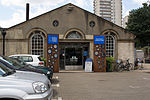London Museum of Water & Steam
 |
|
| Established | 1975 |
|---|---|
| Location | Brentford, England |
| Public transit access |
|
| Website | waterandsteam.org.uk |
London Museum of Water & Steam is an independent museum founded in 1975 as the Kew Bridge Steam Museum. It was rebranded in early 2014 following a major investment project.
Situated on the site of the old Kew Bridge Pumping Station in Brentford, near Kew Bridge on the River Thames in West London, England, the Museum is centred on a collection of stationary water pumping steam engines dating from 1820 to 1910. It is the home of the world’s largest collection of working Cornish engines, including the Grand Junction 90 inch, the largest such engine in the world. The site is an anchor point on the European Route of Industrial Heritage (ERIH).
The Museum reopened on 22 March 2014.
Kew Bridge Pumping Station was originally opened in 1838 by the Grand Junction Waterworks Company, following a decision to close an earlier pumping station at Chelsea due to poor water quality. In the years up to 1944 the site expanded, ultimately housing six steam pumping engines as well as four Allen diesel pumps and four electric pump sets. The steam engines were retired from service in 1944, although two were kept on standby until 1958, when a demonstration run of the Harvey & Co. 100 inch engine marked the final time steam power would pump drinking water at the site.
The Metropolitan Water Board decided not to scrap the resident steam pumping engines and set them aside to form the basis of a museum display at a later date. This action bore fruit in 1974 with the formation of the Kew Bridge Engines Trust, a registered charity, by a group of volunteers previously involved in the restoration of the Crofton Pumping Station.
Today the site is an internationally recognised museum of working steam pumping engines, a reminder of the many pumping stations spread throughout London and the UK. In 1999, the United Kingdom government Department for Culture, Media and Sport described Kew Bridge as "the most important historic site of the water supply industry in Britain".
...
Wikipedia
